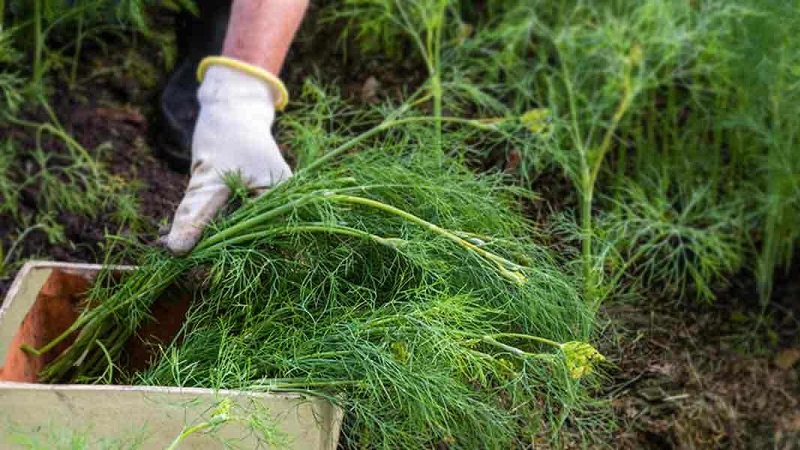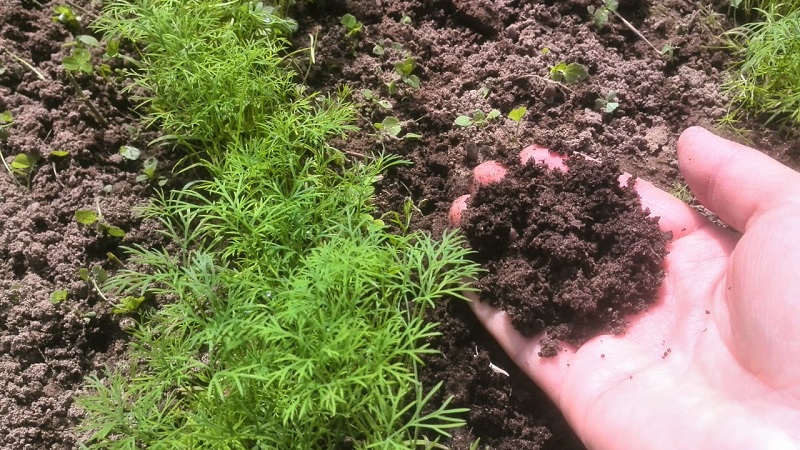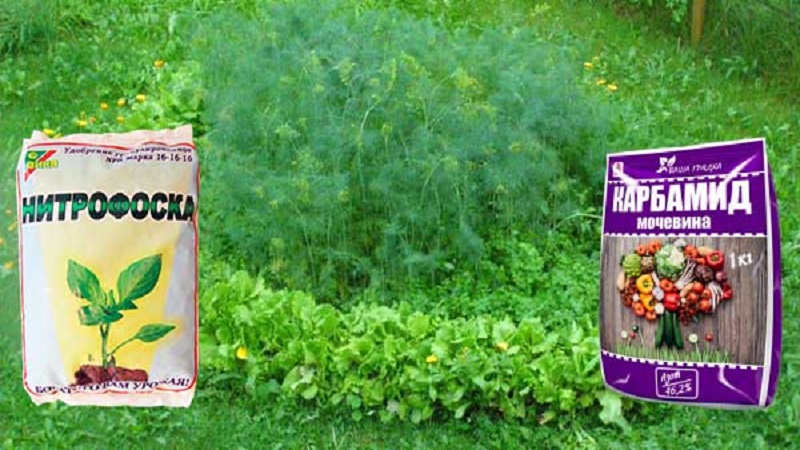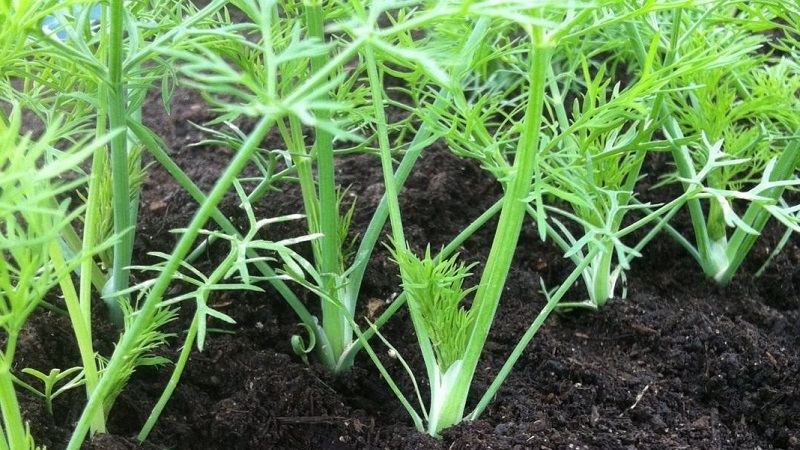Dill grows poorly - how to feed for a good harvest and how to do it right
Not all gardeners grow lush green bushes of dill, sometimes it does not sprout at all, rots, and acquires a yellow tint. The article describes the rules relating to all stages of growing these greens: how to prepare the soil, what fertilizers are needed, what affects the growth and yield of dill.
The content of the article
Why dill grows poorly and how feeding will help
Several factors affect the growth of dill.:
- sowing site selection;
- correct seed preparation;
- timely feeding.

These greens cannot be classified as demanding plants., however, non-compliance with the recommendations negatively affects the yield.
Important! Sow seeds only in a well-lit place. If you plant them in the shade, the greenery does not come up at all or does not grow well, it looks sluggish.
Seeds for planting are harvested on their own using last year's harvest, or bought in a store or pharmacy.
Prepare them for sowing in three ways:
- soaking for several days in water;
- soaking in vodka for 15 minutes (after which they are thoroughly washed and dried);
- saturating the seeds with oxygen (bubbling) - you can lower them into a container of water, where the aerator is immersed (suitable for the aquarium).
Seeds are planted only in moist, fertilized soil - this is one of the main conditions for a bountiful harvest. After sowing, intensive watering with warm water is required.
Care advice:
- dill has long roots, so the layer of nutrient soil should be at least 30 cm;
- the most favorable soil for greenery is sandy loam or loam;
- dill does not like an acidic environment, therefore, the permissible soil pH level is from 6.5 to 7;
- plantings are thinned to 2 cm.

Terms of feeding dill
Before planting seeds, fertilize the soil inorganic substances.
Second feeding carried out 15 days after sowing.
Subsequent feeding depend on the condition of the plant.
It can be useful:
How to feed dill for good growth
There are several ways to feed dill. The method is chosen taking into account the stage of growth of greenery, variety and its state.
Purchased ready-made products
Use superphosphate and potassium salt or Nitroammophos to prepare the soil and create a dill-friendly environment.
About 2 weeks after germination, the greens are fed with any of the means:
- ammonium nitrate;
- Biud;
- Baikal-M1;
- "Emochki";
- "Radiance".

Traditional methods
For plant feeding also use homemade and organic fertilizers:
- humus;
- mullein;
- "Green infusion", which is prepared from nettles or other weed cuttings;
- ammonia.
Top dressing for open ground / greenhouse
For feeding dill planted in the open field, mullein, nettle infusion, urea are perfect.
If dill is grown in a greenhouse, then during planting it is recommended to place superphosphate between the grooves, and in the future to use nitrogenous fertilizers.
Top dressing instructions
Superphosphate and potassium salt are used for saturation of the soil with nitrogen and phosphorus. Before sowing seeds, these agents are mixed with the soil at the rate of 20 and 30 g per m², respectively.
Ammonium nitrate is used for top dressing of dill about 15 days after sowing.Used in small quantities: no more than 8 g per m².
Important! Dill is an early ripening culture. The use of chemical fertilizers, especially ammonium nitrate, promotes the accumulation of nitrates in greenery. To avoid this, strictly observe the dosage.
Organic fertilizers are recommended to be used in proportions:
- humus - 1/2 bucket per m²;
- mullein - solution with water in a ratio of 1:10;
- "Biud" - a solution with water in a ratio of 1:20.
EM fertilizers are applied in accordance with the instructions on the package.

Urea is used for elimination of nitrogen deficiency in the soil. Urea (or carbamide) is diluted in water. The recommended concentration is 20 g / m². The solution is watered with dill about 2 weeks after germination. Reprocessing with urea is not recommended.
Traditional methods make it possible to produce high-quality fertilizers without pesticides.
"Green infusion" is prepared as follows:
- collect young shoots of nettle without seeds and place them in a large container, filling it halfway;
- the remaining half of the container is added with water, covered with a lid;
- insist for 2-3 weeks;
The concentrated solution is diluted with water in a ratio of 1:20 and used for irrigation at the rate of 1/2 bucket per m² 2 times a month.
Top dressing with ammonia (aqueous ammonia solution) will provide fast growth and attractive green appearance. Prepare a solution: 10 ml of alcohol per 10 liters of water. In dry, calm weather, the plants are abundantly sprayed with the resulting solution.
Read also:
Useful tips and common mistakes
Timely and hassle-free tips to get a crop of beautiful and fragrant dill:
- The key to an excellent dill harvest is proper soil preparation. If the soil is sufficiently fertilized before planting, additional feeding of the greens will not be needed.
- Dill seeds are rich in essential oils that make germination difficult. Therefore, seeds germinate best if they have wintered in the open field, and processed and disinfected before spring planting.
- To get an early harvest of dill, it is permissible to sow it in a box and grow it on a windowsill, and plant it in open ground 35 days after planting.
- Greens are able to withstand frosts down to -4 ° C, so you can plant them immediately after the snow melts.
- It is not recommended to plant dill next to carrots, herbs and caraway seeds, and potatoes, cucumbers and garlic are excellent neighbors.
- The yellow color of dill and its rapid flowering indicate a lack of moisture. A red color indicates that the soil is too moist and contains a lot of potassium.

Reviews
Novice gardeners note that growing dill turned out to be more difficult for them than they expected.
Alla, Ryazan: “It would seem that what could be easier than growing several beds of dill. However, when we bought a new plot and I sowed dill, it did not grow well, the bushes were scarce and dim. It turned out to be the soil. After fertilizing the soil with potash salt, the harvest of greenery always makes us happy ".
Vladimir, Mga: “I have never done gardening before. For the first time, my wife and I bought a dacha and decided to grow something. We wanted to start with the simplest thing - with herbs, so that there were fresh dill and parsley on the table. But the dill was yellow and thin. We were advised to use the Biud product and spray the plantings with ammonia solution. The result was not long in coming - now we eat delicious greens right from the garden. ".
George, Barnaul: “I decided to go into business - to grow dill for sale. To do this, he sowed seeds in a greenhouse. But the greens were not good for sale: the appearance was so-so. On the advice of friends, he began to fertilize the plantings with mullein and humus. The funds helped - now the dill is of excellent quality ".
Conclusion
Despite the fact that dill is an unpretentious crop, its cultivation can cause a lot of trouble for a gardener.For a good harvest, it is enough to follow simple recommendations: choose the right planting site, prepare the soil and seeds, and feed greens if necessary.
When using ready-made chemicals, keep in mind that dill tends to accumulate nitrates, so it is important to take precautions.